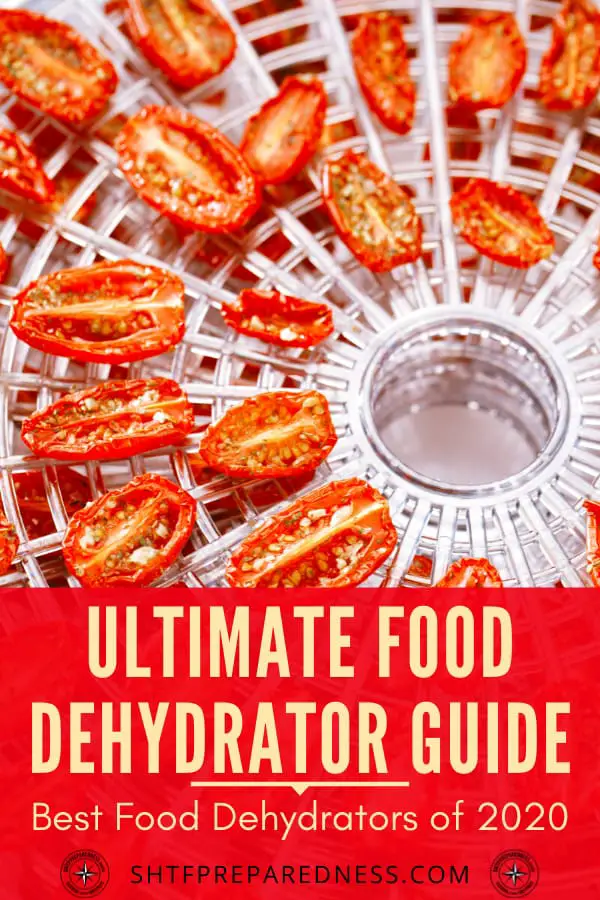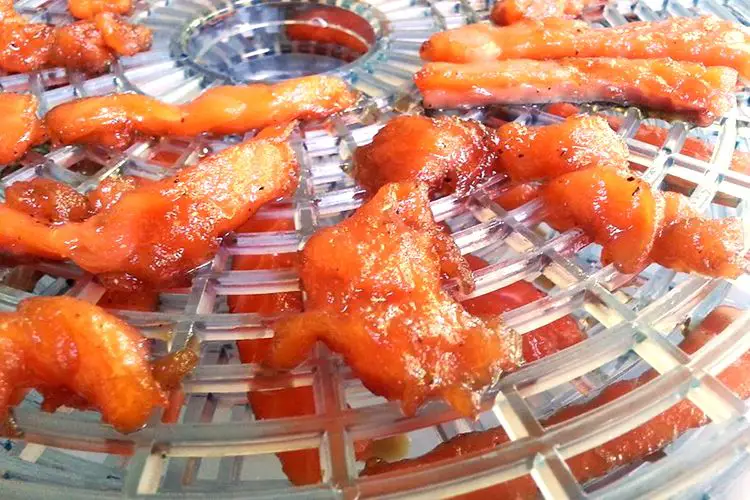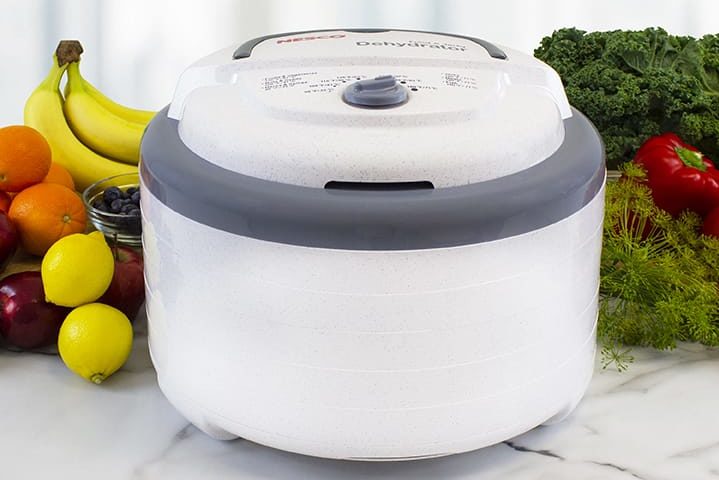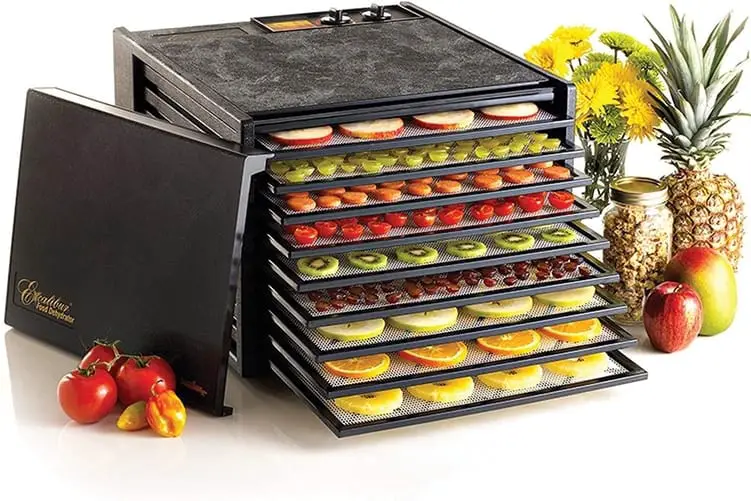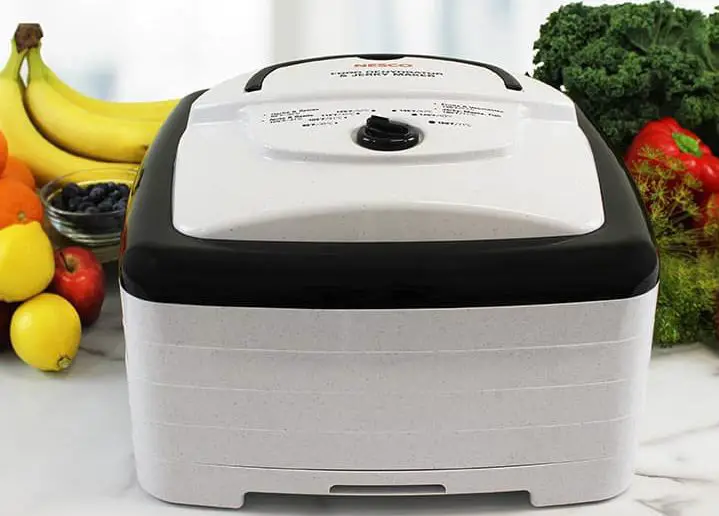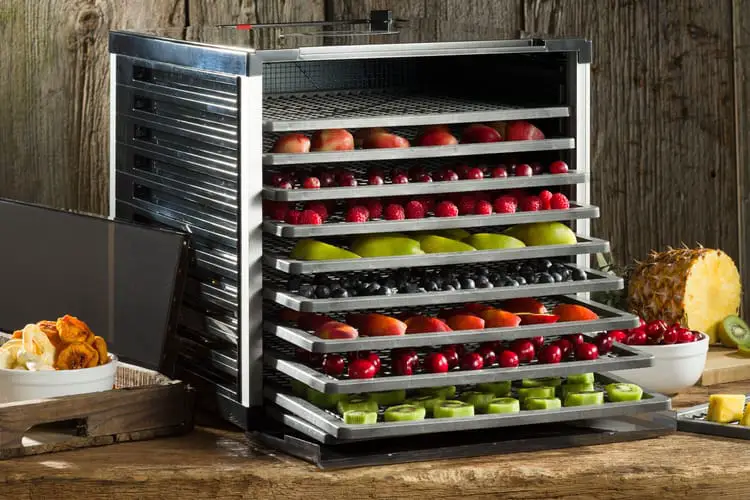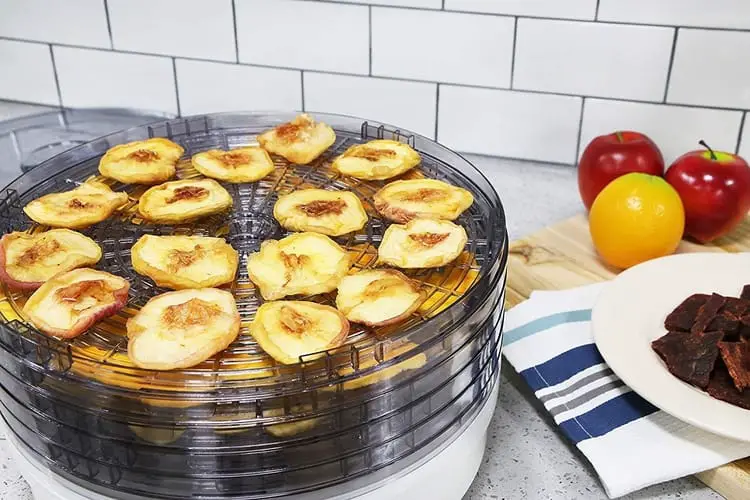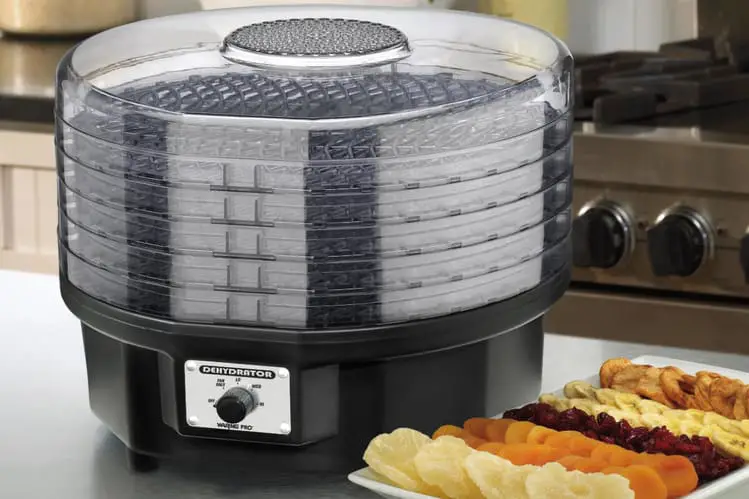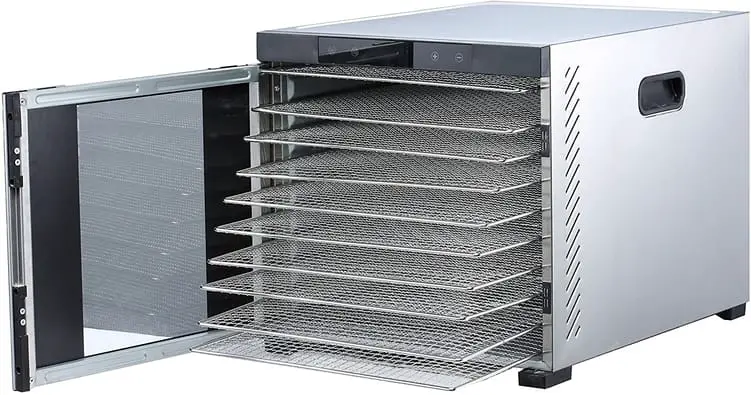Industrial agriculture, food shortages, and just the cost of food have many people wondering about our food system.
If you have the ability to grow and dehydrate your own food, you take back some control. A food dehydrator is a powerful tool that can be used to make dry meals and ready-to-eat snacks.
With over 100 different types of dehydrators on the market, you need a comprehensive food dehydrator guide to make it easy for you.
The best dehydrators are going to be those that work efficiently, save space on the countertop, and also give you the ability to pack a lot of food into the racks.
If you are dehydrating a bushel of apples, do you want the dehydrator that can do that in 5 courses of dehydration or 10? In creating this guide, we searched high and low to find the 7 best food dehydrators on the market.
Not only are we going to look at the ultimate food dehydrator, we are also going to cover the dehydration process, recipes, benefits, and much more. When you finish reading this, you will know exactly which model you want and why.
How is Food Dehydrated?
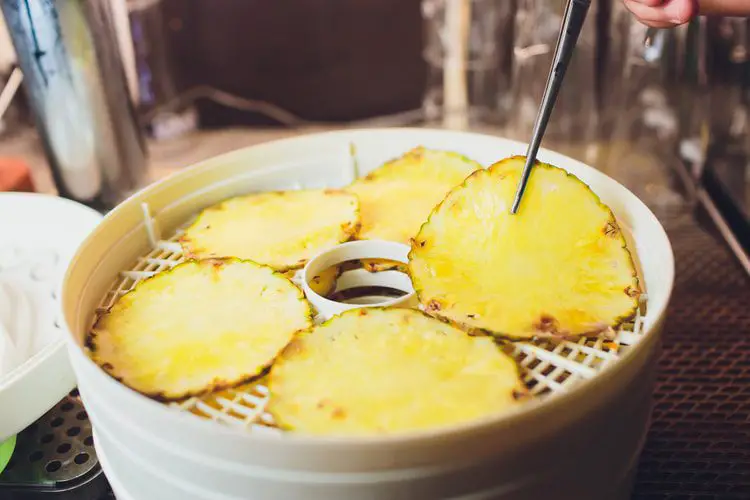
If you are going to invest in dehydration as a means to save money and provide your family with more nutritious foods, you should understand it.
Dehydration is one of the oldest methods of food preservation and has remained mostly unchanged for thousands of years.
A Brief History of Dehydration Methods

The reason dehydration works is because it removes one of the most important elements of bacterial growth: water. With the moisture removed, bacterial growth is slowed substantially and can even be halted.
It’s likely that the first dehydrated foods happened by accident. They would have been foods that were left out in the sun and changed radically in texture. A mixture of sun and wind would be how this natural dehydration would have happened.
Around the world, cultures have figured this out and taken steps to increase the speed and efficacy of dehydration.
Hanging foods and meats was a very popular method when it came to drying foods. The addition of smoke was another means of increasing the speed and efficiency of dehydration.
Meats were always very popular foods to be dehydrated, and fishing cultures would hang and smoke fish while gregarine societies would hang and smoke things like hams and cuts of meat.
Modern Dehydration Methods
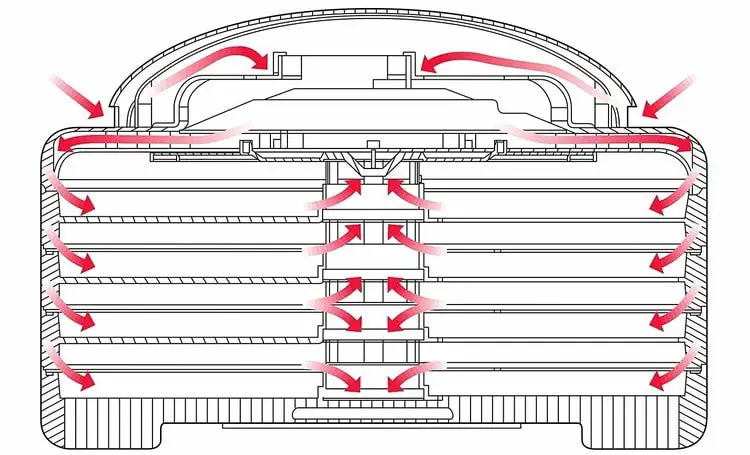
Dehydration still happens in homes all over the world. Even in our radically convenient society, Americans still dehydrate foods. One of the biggest industries that depends on the dehydration process is that of spices and dried herbs.
For the average person, dehydration has become a countertop process that requires airflow and heat. Modern dehydrators, like those mentioned in this ultimate food dehydrator guide, make a world of difference in the process.
With no need for the sun’s light and heat, dehydration happens overnight in most homes.
You can also use a slow oven to dehydrate foods. However, the airflow and overall results are far superior in a modern dehydrator.
Solar Dehydration
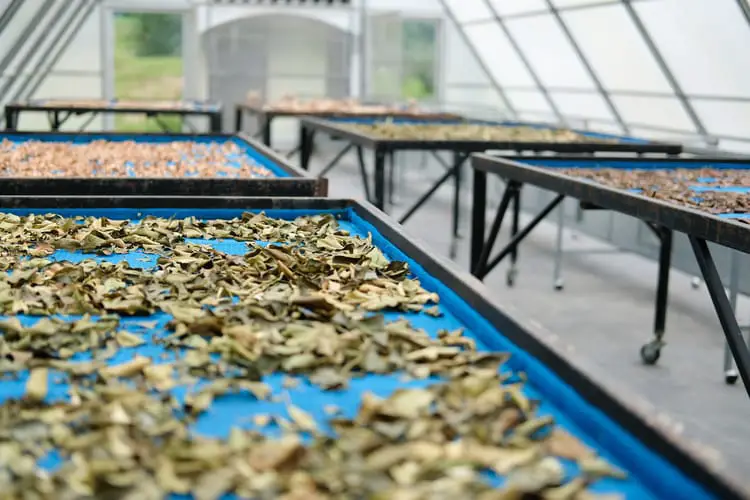
The inclusion of things like salt in curing and drying foods was another huge step in the preservation of foods. However, the sun played the biggest role.
Salt was precious, and many would prefer not to use it if they could get the sun and wind to do most of the work. That was the case for most cultures.
Solar dehydration has been mastered in the modern age, and we now have tremendous success attracting the sun, holding heat, and circulating air. Anyone can invest in a solar dehydrator and have great results in their own backyard.
Here at SHTFPreparedness, we found the best ever solar food dehydrator plans so you can give the DIY angle a try.
Mylar and Oxygen Absorbers
- FITS PLENTY OF ITEMS! - Whether its food, pharmaceuticals,...
- EASY TO SEAL! - Use a hot iron to heat seal these bags shut...
- KEEP YOUR ITEMS DRY! - These moisture barrier bags keep all...
Technology has made food dehydrators very effective and has also changed how long we can store our dehydrated foods.
Dehydration often yields a lot of food. There is a lot of prep work, and the food shrinks, but you are still left with a lot of dry food that needs a place to live in your pantry.
Mason jars and Ziploc bags are great options for storing dehydrated foods. However, if you are interested in taking advantage of your newly dehydrated foods, you could invest in Mylar bags and oxygen absorbers. These can exponentially increase shelf life.
By adding oxygen absorbers to the mix, you take away moisture (through dehydration) and oxygen from the environment. Bacteria simply cannot grow in an environment like that. In fact, there isn’t much that can!
The Mylar bags can be heat sealed and offer more protection than a typical Ziploc bag.
If you are going to be storing your dehydrated foods for the long term, these are important to have on hand.
Benefits of Dehydrated Foods
Diet and the nutrients we take into our bodies have become subjects of science and health.
It has been proven that how we feed our body dictates its performance. A poor diet can be linked to many poor choices in the foods we eat.
It is in the modification of the diet that we see the biggest benefits of dehydrated foods.
Are Dehydrated Foods Good for You?
Dehydrated foods are good for you and for those you live with.
You will save money on buying all sorts of things when you start dehydrating foods. Just the money you save on food waste alone will blow you away. Food waste disappears because when things sit around too long, they get dehydrated.
Dehydrated foods also have a tremendous taste. You are taking the sweetness and character of that which you dehydrate and enhancing it.
These foods are more appealing! Learn how to dehydrate apples, and the people in your household will eat dried apple snacks instead of cookies! Particularly if you stop buying the cookies.
Do Homemade Dehydrated Foods Lose Nutrients?
Perhaps the best answer to this question is that those who practice a raw food diet lean on dehydrated vegetables and fruits. This is because many of the nutrients are not only still there, but some even get concentrated.
If you are after nutrients, you are going to benefit greatly from eating dehydrated foods. It might be time to buy your own food dehydrator.
The Ultimate Snack
If you are looking to affect your diet, you need to look at how you snack. We can fast, wake up, and eat a healthy breakfast, but if we spend the afternoon snacking on junk, we undo a lot of our work.
If you can reach for a bag of dehydrated cinnamon-coated apples, it will have a huge effect on your overall health. That is what a quality food dehydrator can do for you.
The same trick works on your kids! Take out the fruit snacks and add the dehydrated fruit leather. This will not only change their overall health, but it will also change their palates.
Kids who eat fruits and vegetables prefer them to sugary snacks. It’s learned, and that makes dehydrated foods the ultimate snack.
What Can You Cook with a Food Dehydrator?
You can dehydrate all kinds of great foods.
Most people think of things like fruits when it comes to dehydrated foods. However, there are all kinds of fun things you can do with dehydrated vegetables, meats, fish, and even dairy!
A good food dehydrator is an indispensable kitchen appliance that every American should own.
Fruits and Vegetables
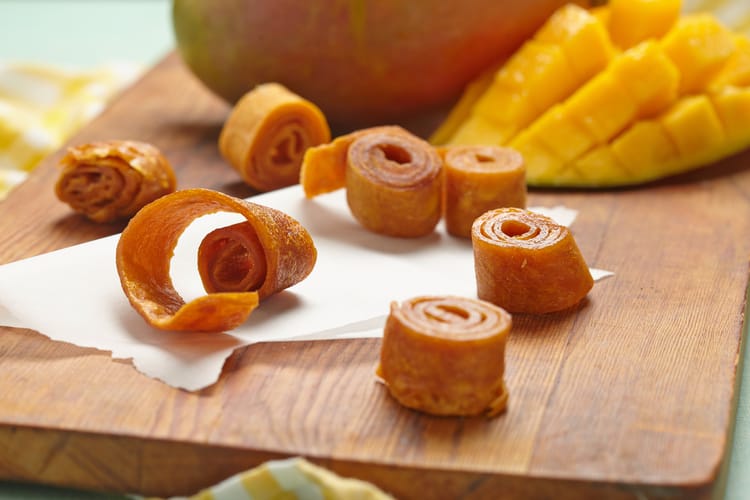
Diced or sliced, fruits and vegetables are absolutely delicious when they are dehydrated. You can make incredible recipes like fruit leather or just dehydrate onions, carrots, and celery to drop in soups and stews.
It can be as complex or as simple as you like. The best thing about owning a food dehydrator is that there are no real boundaries.
Have you ever had dehydrated mango? Sprinkle a little cayenne pepper on the mango slices before dehydrating, and it will change your life!
Vegetables can be dehydrated and combined with dehydrated meats, rice, or pasta to make incredible meals that just need to be boiled. These are huge time-savers.
Meats
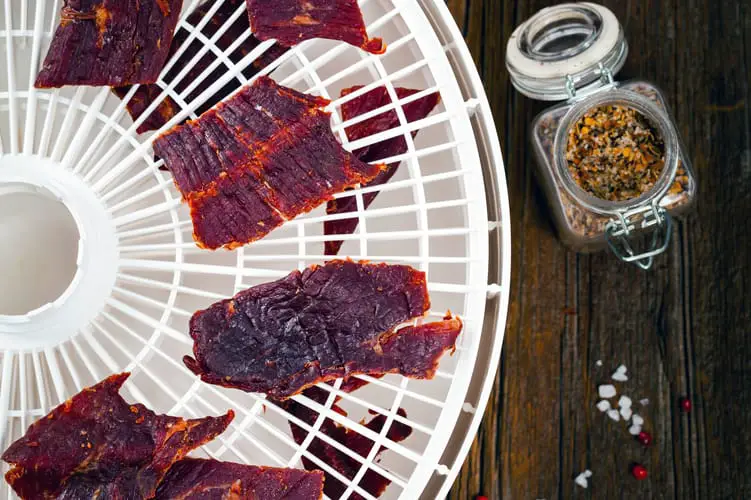
Of course, beef or turkey jerky comes to mind when you think about using a dehydrator on meat. That is because jerky is such a tasty treat.
Have you ever considered using chicken scraps or chicken tenderloins to make fresh, 100% natural dog treats?
Oh yes! You can dehydrate a variety of scraps and use them to make pet treats without adding things like flour or other additives.
Fish
Dried fish is a unique ingredient. In Asia, it’s used as much as a flavoring as it is a staple protein.
Fish is loaded with health benefits. Typically, the worst price you get on fish is when you buy it one filet at a time.
With a food dehydrator, you could buy whole sides of salmon, eat it fresh, and then dehydrate it to make salmon candy, which is a delicious and nutritious Native American snack.
Dairy
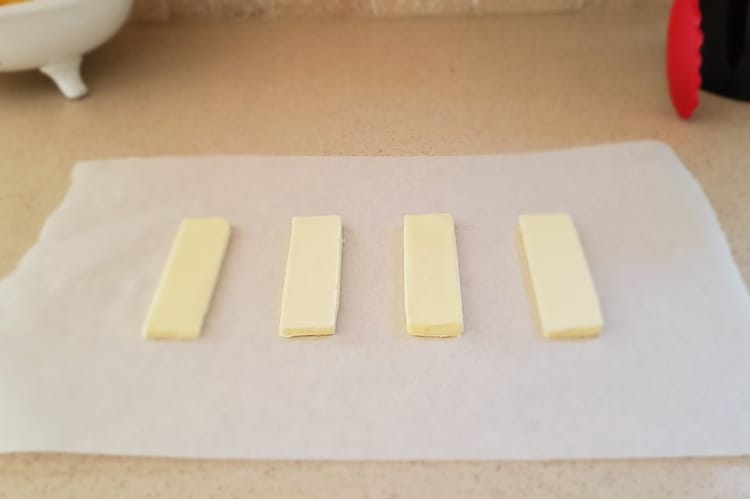
You have probably never considered dehydrating dairy!
That is not surprising. Diary doesn’t do well with heat, and lots of these food dehydrators use some form of heat in the process.
You will find that things like milk, yogurt, and even butter can be dehydrated. It helps to use something like an ice cube tray to hold liquid dairy. However, yogurt can be spread out on a Silpat non-stick mat and dehydrated all the same.
The real trick is to dehydrate butter and butter substitutes. However, it is possible and allows you to store butter for the long term or sneak it into recipes.
Other Foods to Dehydrate
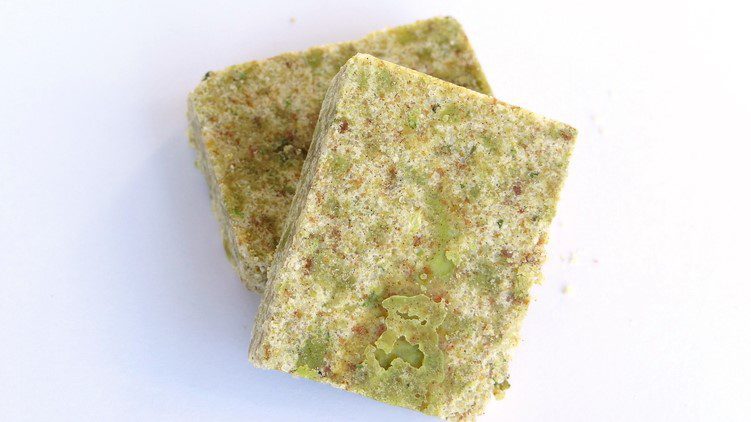
Another popular food to dehydrate is broth. It can be used to make soup or sauce later. Homemade make-ahead bouillon cubes are one of my favorite camping food ideas!
You can also use your food dehydrator to speed up the drying of herbs. This can save you from buying them at the supermarket.
What to Look for in a Food Dehydrator
A quality food dehydrator is going to create dehydrated foods for you that are dry and ready for storage.
This is usually done through a combination of heat and flowing air. There are other important qualities to look for in the ultimate food dehydrator.
Capacity
Dehydrating food requires a lot of processing. You will be trimming, seeding, and dicing. After that, it gets easier.
The amount of food your dehydrator can hold will determine how long you run the unit and how long the process will take.
High-capacity units are great, but they will cost more money. They could also hold more food, but they might have to be cut smaller. So, more processing is needed.
Consistency
When you dehydrate an apple for 6 hours, in your dehydrator, you want it to look just like the last apple you dehydrated for 6 hours. Assuming it is cut to the same size,.
This is a matter of consistency. Even heating and effective airflow are important pieces of food dehydrator functionality.
An inconsistent dehydrator could be dirty, clogged, or just a poor performer in general.
Assembly and Disassembly
After you dehydrate food, you are going to need to clean your unit. Depending on the model you have, this could mean a simple process or a nightmare.
How a dehydrator comes apart and how it goes back together plays a huge part in the overall operation.
Look for a food dehydrator that is easy to set up and break down. This will ensure you can dehydrate more food more often.
Who Makes the Best Food Dehydrator for All-Around Use?
We have seven great models to compare in our ultimate food dehydrator guide.
Nesco FD 75A Snackmaster Pro
BEST ALL-AROUND MODEL
The Nesco is made in America and features 600 watts of power and an adjustable temperature range that reaches 160 degrees!
You will receive fruit roll sheets for making fruit leather, screens for dehydrating, and a 52-page recipe book to keep you busy throughout the process.
Nesco also sells extra trays if you are interested in expanding on what your dehydrator is capable of.
The Nesco Snackmaster Pro stands out because of its ease of use for beginners but also because of its ability to meet the needs of a seasoned dehydrator.
Excalibur 3926TB 9-Tray Dehydrator with Timer
BEST HIGH-END MODEL
The Excalibur 9-Tray Dehydrator is the creator of top-tier dehydrators that are designed to save space and be highly efficient.
This model is no exception, as it features 9 trays and 9 screens for maximum food dehydration capacity. You will run out of food to stuff in this thing!
The Excalibur also features an intuitive timer that can monitor your food for 26 hours. It will also turn itself off while you sleep and when you are away from home.
Rather than depending on one powerful fan, the Excalibur 9-Tray dehydrator offers up airflow fans for each of its trays. This assures that every single piece of food on your tray gets powerful, heated airflow to aid in the dehydration process.
Nesco FD-80A Food and Jerky Dehydrator
BEST MODEL FOR MAKING JERKY
This quiet but powerful dehydrator features the Converga Flow fan that forces air up and through your trays to assure maximum efficiency in your dehydrating process.
Nesco dehydrators are made in America, and the quality of these food dehydrators shows through.
This unit features a timer that allows you to run a 24-hour dehydration cycle. This means you are going to get even dehydration from top to bottom on everything you place in the Nesco.
Because of its unique temperature control and powerful heated airflow, the Nesco Food and Jerky Dehydrator dries food up to four times faster!
LEM 1153 Mighty Bite 10-Tray Double Door Dehydrator
LARGEST DEHYDRATING SPACE
This 10-tray food dehydrating powerhouse has the ability to power air through all of its trays using a rear-mounted fan.
The LEM Might Bite dehydrator features temperature control to assure you have consistent heat blowing through the unit at all times.
This will promote even drying with all of your dehydrated foods. Consistent heat and airflow are critical features of a good-quality food dehydrator. Particularly in large ones.
The bottom hinged slide-away door gives you great access to over 15 square feet of surface area between the 10 trays. It also makes learning a breeze!
Elite Gourmet EFD-1010 5-Tray Dehydrator
MOST AFFORDABLE
Coming in at a cool $37 as of this writing, the Elite Gourmet 5-tray dehydrator is one of the most affordable models on the market.
If you are interested in dehydrating food on a budget, there is no better model on this list.
The Elite Gourmet dehydrator features 5 removable plastic trays that are both easy to load up with food for dehydration and easy to remove for cleaning.
The trays are see-through, so you can monitor the food from a distance without disrupting airflow.
The Elite Gourmet lacks some of the features that we have highlighted in the other models. For example, it lacks an intuitive timer and temperature controls. However, it is a great beginner model for someone on a budget who is new to dehydrators.
Cuisinart 5-Tray Food Dehydrator
BEST RUNNER-UP FOR JERKY
Cuisinart, a well-established name in kitchen appliances, boasts a powerful 620-watt food dehydrator with this model.
A simple temperature control dial gives you options for how warm you want the flowing air to be. With 5 trays, you can still be pretty efficient in the quantity of food that you are dehydrating per session.
The compact design makes managing this unit a breeze, both when in use and when being stored. This is not a bulky dehydrator that will take up your entire counter. You can simply leave it out during the growing season or when you are doing a lot of dehydration.
The Cuisinart DHR-20 is one of our favorites and will make better beef jerky than any you can buy at the store!
Samson “Silent” 10-Tray Stainless Steel Dehydrator
MOST DURABLE
There is just something about stainless steel! The trays on the Samson “Silent” 10-tray stainless steel dehydrator are metal as well. This makes it one of the most durable dehydrators that we are aware of.
It also features a glass door and all the power you could want in a dehydrator.
The interactive LCD screen gives you the ability to control temperatures up to 167 degrees, one degree at a time.
It also features an effective timer that will watch your food for over 19 hours! The timer schedule can be broken up into increments if you are unsure about the best drying time.
Dealing with glass and stainless steel means you can really get in there and clean the Samson “Silent” dehydrator.
If you are concerned about the cleanliness of your dehydrator, be sure to look into this model. It can really be scrubbed and cleaned impeccably without concern for screens or plastic.
How to Clean and Maintain a Food Dehydrator
The cleaning, storage, and maintenance of your food dehydrator are paramount to its long-term use.
A well-kept machine will be around for many years. However, a machine that is not kept will need to be replaced.
A great place to start would be the user manual, because it will offer advice for your particular machine.
Cleaning
You started down this path to eat better and more natural food. So, don’t gum your machine up with harsh chemicals and solvents that could affect the quality of your dehydrated foods.
Instead, lean on natural cleaners and use things like baking soda and vinegar. There are some important tools to have on hand for cleaning your dehydrator:
- Non Abrasive Sponges
- Good Gloves
- Toothbrush (Secret Weapon!)
Storage
Proper storage in your food dehydrator begins with drying. Standing water is the worst enemy of a food dehydrator. Be sure you either towel dry after cleaning or leave it to drip dry overnight.
In most cases, your dehydrator is going to be best stored with all its pieces together. Keep that in mind.
It might also be worth reserving a shelf in your pantry for your dehydrator and any accessories. You will want a place for extra trays and mylar bags if you go that route.
On a final note, access to your dehydrator should be easy. If you bury it behind a bunch of junk, you aren’t going to want to pull it out and use it.
Conclusion
A food dehydrator is an essential kitchen appliance for the survivalist, homesteader, or anyone interested in self-reliance and independence.
Remember, when you have dehydrated foods, you are only a mylar bag and oxygen absorber away from long-term emergency food storage.
Take control of snack time with delicious dehydrated foods. Whether you decide to make fruit leather or just do simple dehydrated apples or strawberries, you will no longer reach for the chips! You might reach for the banana chips!
Each one of these units has earned its place in the ultimate food dehydrator guide. No matter which one you choose, you will be very happy, and it will change the way you grow food, store food, and eat on a daily basis.
Stop leaving your emergency food storage and healthy diet choices at the supermarket! You have more power than you think!
